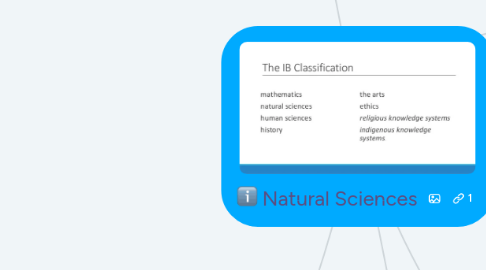
1. Scope & Application (Katie)
1.1. Natural sciences is concerned with description, prediction, and understanding of the natural phenomenas, based on evidence from observation and experimentation.
1.1.1. They use methods such as peer review and repetition of findings are used to try to ensure the validity of data and weight it against the original hypothesis.
1.1.1.1. Quantitative Data and Qualitative Data
1.1.1.1.1. Quantitative data is information about quantities, information that can be measured and written down with numbers
1.1.2. Description
1.1.2.1. A description is a spoken or written account of a person, object, or event
1.1.2.1.1. Observation: The color, texture, what you can see is happening in the experiment
1.1.3. Prediction
1.1.3.1. Prediciton is the action of predicting something
1.1.3.1.1. Observation: Think about what you are going to see and what are the products that you think are going to be formed (if there are any)
1.1.4. Understanding
1.1.4.1. Understanding is the ability to comprehend something and apply it to other aspects
1.1.4.1.1. Observation: Do you understand why certain aspects of the experiment are happening that way and if the products react do you understand the science behind why they are
1.2. Natural Science can also be divided into 2 Main Sections these are: life sciences ( also called biological sciences) and Physical Sciences
1.2.1. Biological or Life Sciences focuses mainly on the scope of living organisms and how they interact with their environment
1.2.1.1. Living Organisms include:
1.2.1.1.1. Microorgansims
1.2.1.1.2. Humans
1.2.1.1.3. Plants
1.2.1.1.4. Animals
1.2.2. Physical Science in comparison focus on studying non-living organisms by predictions and experimentations about the universe and our understanding of how we think it works
1.2.2.1. These study topics include:
1.2.2.1.1. Physics
1.2.2.1.2. Astronomy
1.2.2.1.3. Chemistry
1.2.2.1.4. Earth Sciences
2. Historical Development (Audrey)
2.1. Kuhn's paradigm shift: "the progress of science is not as rational as is sometimes thought."
2.2. Thomas Kuhn: introduced the concept of paradigm to the philosophy of science; one should not endlessly test his assumptions
2.3. Science is fallible: the decision of switching from one paradigm to another can be influenced by non-scientific factors like faith, personal ambition, vanity etc
2.4. A paradigm in science should be confirmed by experiment and not based on a belief. It depends on judgement.
3. Methodology (Candice)
3.1. According to reason and sense perception, hypothesis-deduction and induction formed
3.2. Classification and models are the central idea in many of the natural sciences
3.2.1. Classification related to categorisation, the process in which ideas and objects are recognised, differentiated, and understood. So it used in understanding the scientific terminology
3.2.2. Models re useful which can be changed based on new evidence. A model is a representation of an idea, an object and a process or a system which used to describe and explain phenomena that cannot be experienced directly.
3.3. Measurement involves interaction with the world, but this interaction can sometimes changes the aspect of the world we are trying to measure
3.3.1. Through Experiments; measurable, controllable, repeatable
3.3.1.1. After collecting data and interpreting data, we will have the confirmation of the hypothesis by peer review and repetition of the experiments, consensus among experts until provisional truth.
3.3.1.2. Conversely, if the hypothesis discarded, we will get the refutation or falsification.
4. Language & Concepts (Anna)
4.1. Scientists are using the language of math which has become the central language of the natural scientists
4.1.1. They use this mathematical language to be more precise and reduce the vagueness which could effect the process.
4.1.2. Language is how scientists share and distribute their ideas and theories to the world
4.1.3. The language that these scientists use will affect the way people absorb their findings and knowledge
4.1.4. Concepts help people distinguish if the weather or not something is part of the natural science
4.1.5. (concepts) allow us to figure out what makes up the natural sciences
5. Personal Knowledge (Tiana)
5.1. Personal knowledge is the basis of all scientific discoveries; someone finds out something new = scientific discovery
5.1.1. personal knowledge can be tested by society and therefore be turned to shared knowledge
